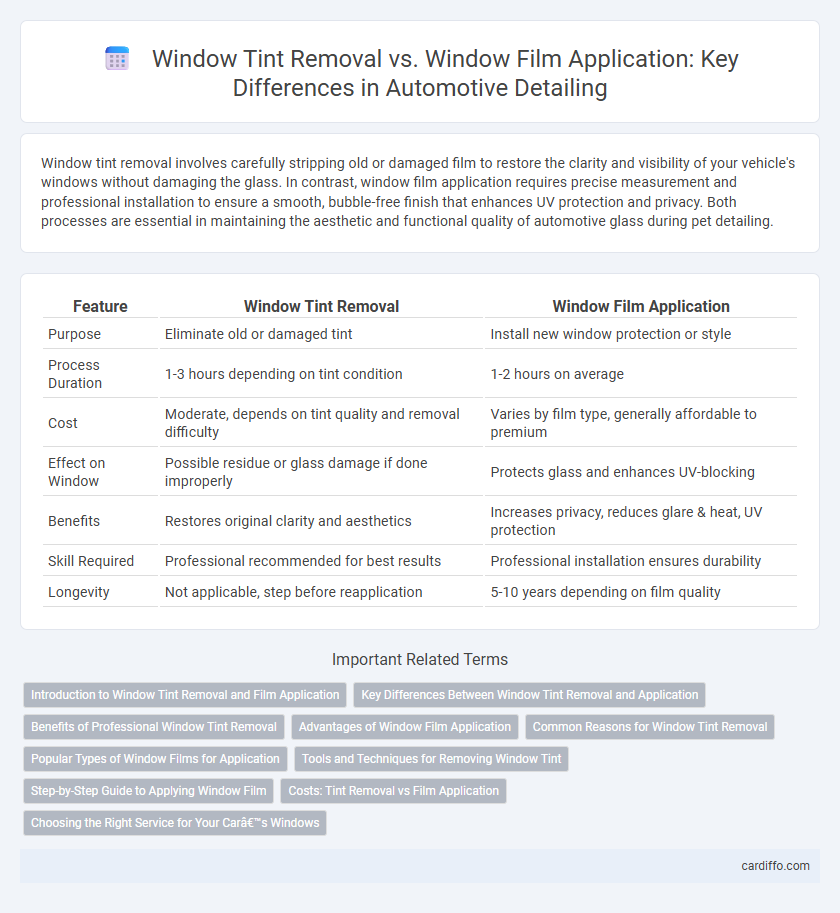Window tint removal involves carefully stripping old or damaged film to restore the clarity and visibility of your vehicle's windows without damaging the glass. In contrast, window film application requires precise measurement and professional installation to ensure a smooth, bubble-free finish that enhances UV protection and privacy. Both processes are essential in maintaining the aesthetic and functional quality of automotive glass during pet detailing.
Table of Comparison
| Feature | Window Tint Removal | Window Film Application |
|---|---|---|
| Purpose | Eliminate old or damaged tint | Install new window protection or style |
| Process Duration | 1-3 hours depending on tint condition | 1-2 hours on average |
| Cost | Moderate, depends on tint quality and removal difficulty | Varies by film type, generally affordable to premium |
| Effect on Window | Possible residue or glass damage if done improperly | Protects glass and enhances UV-blocking |
| Benefits | Restores original clarity and aesthetics | Increases privacy, reduces glare & heat, UV protection |
| Skill Required | Professional recommended for best results | Professional installation ensures durability |
| Longevity | Not applicable, step before reapplication | 5-10 years depending on film quality |
Introduction to Window Tint Removal and Film Application
Window tint removal involves carefully peeling off the existing film from vehicle or building windows to restore clarity and prepare surfaces for new applications. Window film application enhances privacy, UV protection, and heat reduction by adhering specialized tinted layers to glass surfaces. Proper removal and reapplication ensure optimal performance and aesthetic appeal of the window films.
Key Differences Between Window Tint Removal and Application
Window tint removal involves carefully stripping existing film from vehicle or building glass without damaging the surface, often requiring heat and specialized tools, whereas window film application entails cleaning, cutting, and precisely adhering new tint to the glass. Removal focuses on eliminating old, cracked, or faded tint that impairs visibility and reduces aesthetic appeal, while application aims to enhance privacy, reduce UV exposure, and improve energy efficiency. The key differences lie in the process complexity, tools used, and the objective of either restoring a clear surface or installing technology-enhanced film.
Benefits of Professional Window Tint Removal
Professional window tint removal ensures precise, residue-free extraction that protects the vehicle's glass integrity and prevents damage to defroster lines or paint. Experts use specialized tools and techniques to efficiently eliminate old tint, saving time and avoiding costly repairs associated with DIY methods. This service enhances visibility, maintains vehicle aesthetics, and prepares the surface for flawless application of new window film.
Advantages of Window Film Application
Window film application enhances vehicle privacy, reduces heat buildup, and protects interior surfaces from UV damage, offering superior comfort and durability compared to window tint removal. Advanced ceramic and carbon window films improve glare reduction without compromising visibility or signal reception. This investment extends the life of your vehicle's interior while increasing resale value and driving safety.
Common Reasons for Window Tint Removal
Common reasons for window tint removal include damaged or bubbling film, fading or discoloration, and the need to comply with updated local tinting laws. Removing old tint also prepares the surface for high-quality window film application, ensuring better adhesion and enhanced aesthetic appeal. Proper removal techniques prevent residue buildup, protecting the glass and enhancing visibility.
Popular Types of Window Films for Application
Popular types of window films for application include dyed films, which offer basic UV protection and privacy; metalized films, known for their durability and heat rejection properties; and ceramic films, providing superior heat reduction and clarity without interference with electronic devices. Each type varies in cost, effectiveness, and appearance, catering to different vehicle owner preferences and climate needs. Professional application ensures optimal adhesion and longevity, maximizing film performance and overall vehicle aesthetics.
Tools and Techniques for Removing Window Tint
Effective window tint removal requires specialized tools such as razor blades, heat guns, and adhesive solvents to ensure a clean surface without damaging the glass. Techniques involve heating the tint film to soften the adhesive, then carefully peeling or scraping it off layer by layer. Precision and patience prevent residue buildup and prepare the window for a smooth film application, enhancing the vehicle's aesthetics and UV protection.
Step-by-Step Guide to Applying Window Film
Clean the window surface thoroughly using a mixture of water and a few drops of baby shampoo to remove dust, dirt, and oils, ensuring a smooth film application. Spray the soapy water generously on the glass and the adhesive side of the window film, then carefully position the film on the wet surface, adjusting for perfect alignment. Use a squeegee to remove water and air bubbles from the center outward, securing a clear, bubble-free finish that enhances both UV protection and privacy.
Costs: Tint Removal vs Film Application
Window tint removal typically costs between $100 and $150 depending on the vehicle size and tint type, while window film application generally ranges from $150 to $400 based on film quality and coverage area. Removal can save money if existing tint is damaged or faded, but applying a new high-quality film offers enhanced UV protection, heat reduction, and aesthetics that justify the higher price. Budget-conscious customers should weigh immediate tint removal expenses against the long-term benefits and durability of professional window film installation.
Choosing the Right Service for Your Car’s Windows
Window tint removal preserves your car's original glass while eliminating old, damaged film that can impair visibility and reduce heat rejection, ensuring clearer windows and better aesthetics. Window film application enhances UV protection, reduces glare, and improves energy efficiency by adding a new layer tailored to your preferences for tint darkness and heat control. Selecting the right service depends on your vehicle's current condition, desired level of protection, and overall maintenance goals to balance performance and appearance effectively.
Window Tint Removal vs Window Film Application Infographic

 cardiffo.com
cardiffo.com